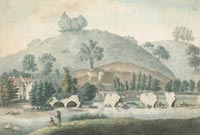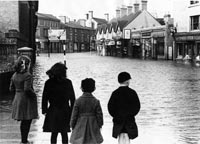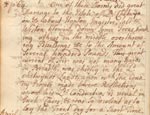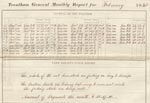
February
Formalised local weather records from the late 19th century indicate the unpredictable and sometimes rogue nature of the weather in February, with snow, frost, fog and rain all occurring along with relatively fine weather in some years. Examples of particularly cold and snowy Februarys in Staffordshire were 1737, 1888, 1895, 1902, 1916, 1919, 1947, 1960 and 1963. What is clear from the archive sources, however, is that February was often month for floods and there are a number of examples over the centuries of bad flooding in Staffordshire in this particular month. These may well have been caused by thawing snow, full rivers and saturated ground. 1737, 1795, 1852 and 1946 were notable examples, 1737 being described as the greatest floods in living memory. Sudden thaws could also cause major damage and problems as in 1795, for example, and the Stafford floods of 1946 still linger in the memory of many local people.
The extracts are arranged chronologically by the day to show the progression of weather through the month.
![]() Biddulph Miners Turn Out to Clear Snow, 4 February 1947
Biddulph Miners Turn Out to Clear Snow, 4 February 1947
![]() Thaw Sets In at Draycott in the Moors, 5- 6 February 1940
Thaw Sets In at Draycott in the Moors, 5- 6 February 1940
![]() Heavy Rain Swells
County’s Rivers, 1852
Heavy Rain Swells
County’s Rivers, 1852
![]() Huntington Children Avoid Wet Feet, 7 February 1899
Huntington Children Avoid Wet Feet, 7 February 1899
![]() Sandon
Mill Foundations Damaged by Water, 8 February 1841
Sandon
Mill Foundations Damaged by Water, 8 February 1841
![]() A Medley of Bad
Weather in Longton, 8 February 1846
A Medley of Bad
Weather in Longton, 8 February 1846
![]() Great Flood Begins in Staffordshire, 10 February 1795
Great Flood Begins in Staffordshire, 10 February 1795
![]() Big Freeze at
Onneley, 8 February 1896
Big Freeze at
Onneley, 8 February 1896
![]() An Especially
Cold Week at Walsall, 9 February 1919
An Especially
Cold Week at Walsall, 9 February 1919
![]() A
Frosty Football Game at Butterton, 13 February 1909
A
Frosty Football Game at Butterton, 13 February 1909
![]() A Very Cold Snap At Weston-under-Lizard, 15-23 February 1895
A Very Cold Snap At Weston-under-Lizard, 15-23 February 1895
![]() Flood Havoc at Stafford: Mayor Opens Relief Fund, 16 February 1946
Flood Havoc at Stafford: Mayor Opens Relief Fund, 16 February 1946
![]() A
Very Personal Experience of the Stafford Flood, 1946
A
Very Personal Experience of the Stafford Flood, 1946
![]() Cold
Children at Alstonefield, 16 February 1898
Cold
Children at Alstonefield, 16 February 1898
![]() Too Cold to Go Out
at Teddesley, 20-23 February 1840
Too Cold to Go Out
at Teddesley, 20-23 February 1840
![]() Snowdrifts in Swythamley,
24-28 February 1916
Snowdrifts in Swythamley,
24-28 February 1916
![]() An Uncomfortable Day
in Hilton, 27 February 1730
An Uncomfortable Day
in Hilton, 27 February 1730
![]() The Greatest Floods
Known, 1737
The Greatest Floods
Known, 1737
![]() Storms Wreak
Havoc at Salt and Weston, 1738
Storms Wreak
Havoc at Salt and Weston, 1738
![]() Bad
Weather Moves Sheep off Tittensor Common, 1833
Bad
Weather Moves Sheep off Tittensor Common, 1833
![]() East Winds
Damage Grass at Trentham, 1840
East Winds
Damage Grass at Trentham, 1840
Biddulph Miners Turn Out to Clear Snow, 4 February 1947
Letter of Thanks to The Manager, Victoria
Colliery, Biddulph, 5 February 1947
1947 was one of the record bad winters of the 20th century
Dear Sir,
At a Meeting of the Highways Committee of my Council held last
night, appreciation was expressed of the assistance given by
employees from your Colliery yesterday in clearing snow from the
main road.
The help then given was a deciding factor in restoring
communications locally and accordingly, I am to tender the best
thanks of my Council for the services rendered.
Yours faithfully,
Clerk of the [Biddulph Urban District] Council
Reference: Staffordshire Record Office D1448/1/180
© Staffordshire and Stoke on Trent Archive Service
Thaw Sets In at Draycott in the Moors, 5- 6 February 1940
 From
the Log Books of Draycott in the Moors Junior School
From
the Log Books of Draycott in the Moors Junior School
The thaw followed some of the worst snowfall in the county for very
many years, preventing children from attending school. Link to
January.
5 February - On Saturday night the thaw commenced, and today
the roads are in an awful state, much worse for the children to
travel along than they were last week. In spite of this, 49 local
children are present out of 86 and 14 evacuated children out of 23
6 February - The thaw continues but the roads are still hardly fit
to travel along…. Current reports of the weather conditions are not
being published as being likely to give useful information to
Germany with whom we are at war. It has now been revealed however,
that the temperatures recently experienced were the lowest for 45
years and that the snowfall of last week was the worst within living
memory.
Reference: Staffordshire Record Office 6838/1/1
© Staffordshire and Stoke on Trent Archive Service
Heavy Rain Swells County’s Rivers, 1852
From the Staffordshire Advertiser, 7 February
1852
The heavy rains which fell almost incessantly about the middle of
the week have swollen the streams in this county to an extent not
witnessed for some years past and in the north of the county the
valleys have been completely under water
William Salt Library: Staffordshire Advertiser, 7 Feb 1852
By courtesy of the Staffordshire Newsletter
Huntington Children Avoid Wet Feet, 7 February 1899
From the Log Book of Huntington Church of England
School
This entry reminds us that, in a less affluent age, children had no
spare shoes to change into on arrival at school.
7 February- 19 children present. Snow thawing, rendering it unwise
for children to risk wet feet.
Reference: Staffordshire Record Office CEL/23/1
© Staffordshire and Stoke on Trent Archive Service
Sandon Mill Foundations Damaged by Water, 8 February 1841
 From
the Diary of Jeremiah Ginders of Sandon
From
the Diary of Jeremiah Ginders of Sandon
Jeremiah Ginders was the agent to Earl Talbot of Ingestre.
8 February- Sandon Mill stopped this morning occasioned by the water
forcing the Soil away from the foundation of the Building and from
under the Grating in front of the Water Wheel
Reference: Staffordshire Record Office 6850/1
© Staffordshire and Stoke on Trent Archive Service
A Medley of Bad Weather in Longton, 8 February 1846
From the Diary of Jacob Marsh, Farmer, of Lane
End, Longton
Sunday 8 February 1846 No going to Church, Wind snow and hail high
wind and storms
Reference: Stoke on Trent City Archives SD 1465
© Staffordshire and Stoke on Trent Archive Service
Great Flood Begins in Staffordshire, 10 February 1795
 |
| Wolseley Bridge depicted after the flood damage of 1795.
Watercolour by W Carter. Reference: William Salt Library SV XII-70 By courtesy of the Trustees of the William Salt Library © William Salt Library Stafford |
The phrase ‘blowing up’ used in this extract raises interesting questions as to what destroyed the stone bridge at Wolseley. Drawings of the remains show the piers in place but the arches collapsed. Given the width of the flood plain, it seems unlikely that they were simply swept away by a great flood, the conventional reason. A clue may lie in the fact that the collapse followed a prolonged period of sub-zero temperatures. It is possible that, if the bridge was poorly maintained, water, seeping into the upper section of the arches and within what engineers call ‘the line of thrust’, froze and began to fracture the structure. As thaw set in, the compression forces which normally held the arch together would have thrust these weakened sections up, resulting in a progressive and catastrophic loss of integrity and, in effect, ‘blowing up’ the bridge.
Memorandum. A Great Frost and Inundation.
A great Frost & Snow began on Monday December 22nd 1794 which with some Intermissions continued till Monday February 9th 1795 which was exactly seven Weeks – A very severe Winter- On Monday Jan 26th Fahrenheit’s Thermometer was at 30 or Freezing Point, others at 23 & some lower. The Rivers Trent and Tame were frozen over, the Corn-Mills unable to Grind, Wheat sold at 9s per strike. A great Flood succeeded upon the Thaw on Tuesday February 10th 1795 On which day, great Damage was done by the amazing Quantity of Ice and Waters to several Bridges- viz [namely] Kings Bridge and the Bridge next to the Swan Inn at Whichnor, both of them over the Trent on the Turnpike Road leading from Lichfield towards Burton upon Trent were washed down. The Spring Planks on the side of the Canal leading from Alrewas to Whichnor Church were washed down. The Beautiful Bridge at Wolseley was blown up; the Bridge at Tamworth called Lady bridge was also blown up, and one Man drowned and two others were with great difficulty saved from perishing. The Aqueduct belonging to the Coventry Canal near Fazeley was not much damaged.
Reference: Staffordshire Record Office D783/1/1
By courtesy of the Vicar and PCC of Alrewas, All Saints
© Staffordshire and Stoke on Trent Archive Service
Big Freeze at Onneley, 8 February 1896
From the Log Book of Onneley Church of England
School
8 February - Attendance still poor owing to the unusually severe
weather. The Infants have scarcely attended at all for the last
Month as the mornings are so bitterly cold, and those who have
attended have been almost frozen when they got to school.
Reference: Staffordshire Record Office D3662/1
© Staffordshire and Stoke on Trent Archive Service
An Especially Cold Week at Walsall, 9 February 1919
From the Service Register of St Peter’s Church,
Walsall
The register records the number of the congregation taking
communion, not necessarily the whole congregation. Nevertheless the
comment about the weather suggests a low turn-out on this particular
Sunday.
|
Date |
Hour of service |
Day of service |
No of communicants |
Remarks |
|
9 February |
7-15 am 8-00 am 11-0am |
5th Sunday after the Epiphany |
4 25 5 |
Very severe weather. The coldest Sunday of the
Winter. The coldest week for 24 years. |
Reference: Staffordshire Record Office D6876
By courtesy of the Vicar and PCC of Walsall St Peter
© Staffordshire and Stoke on Trent Archive Service
A Frosty Football Game at Butterton, 13 February 1909
From the Diary of a Local Farmer
13 February 1909 -A Very Fine Sharp Frosty Morning. Will went to
Wheeldons with my Shoes to be Sold and healed. Mr Ward came in good
Time with papers. Post called With paper. Hulme End & Grindon Tied 2
goals Each at Butterton for Charity cup
Reference: Staffordshire Record Office D6794
© Staffordshire and Stoke on Trent Archive Service
A Very Cold Snap At Weston-under-Lizard, 15-23 February 1895
From the Weather Books of the Weston Park Estate
|
Date |
Max Temp |
Min Temp |
Wind |
Barometer |
Rainfall |
Remarks |
|
15 February |
31 |
13 |
NE |
29.85 |
0 |
Ice on Temple Pool 9½ inches |
|
16 February |
34 |
19 |
NE |
29.96 |
0 |
Ice on Temple Pool 9½ inches |
|
17 February |
37 |
10 |
N |
30.07 |
0 |
|
|
18 February |
33 |
14 |
NE |
29.94 |
0 |
|
|
19 February |
37 |
28 |
E |
29.78 |
0 |
Ice on Temple Pool 10½ inches |
|
23 February |
43 |
29 |
NW |
29.90 |
0 |
Ice on Temple Pool 11½ inches |
Reference: Staffordshire Record Office D1287
By courtesy of the Trustees of the Weston Park Foundation
© Staffordshire and Stoke on Trent Archive Service
Flood Havoc at Stafford: Mayor Opens Relief Fund, 16 February 1946
 |
| The Stafford Floods, February 1946, as seen from the corner of
Lichfield Road, Stafford By courtesy of Peter Rogers Photographic, Stafford. |
Stafford was one of the towns most seriously affected by widespread flooding which occurred in the West Midlands at the weekend. The floods in Stafford and the surrounding villages were the worst within living memory and the resultant damage, the full extent of which it is not yet possible to estimate, runs into thousands of pounds.
When the Rivers Sowe and Penk overflowed their banks, large tracts of agricultural land became inundated and by Friday afternoon large parts of Stafford were under water. The main thoroughfares became flooded to a considerable depth and a large number of business premises and houses were affected.
The torrential rain on Friday was accompanied by a steady rise in the level of the Sowe and by the afternoon, Pilgrim Street, Pilgrim Place and Espleys Yard, which are the first roads to become inundated when the Sowe is in spate, were heavily flooded and the occupants were forced to take hurried refuge in upper storeys.
The flood continued to rise with alarming rapidity and in a very short time Newport Road, Bridge Street and Lichfield Road were submerged to a considerable depth. ……. The Public Library and the Odeon Theatre were completely isolated. The foyer of the theatre was ankle deep in water and the auditorium was also flooded…..
Flooding was also reported from other areas of the town, those most seriously affected being Sandon Road, Greyfriars and Lammascote road and a scheme for the evacuation of the families was immediately put into effect. Rest centres were opened…..
Rescue work in the Pilgrim Street area was a hazardous business, police and NFS [National Fire Service] having to wade above their waists in strong currents to reach the flood victims……….
One of the most serious consequences of the flood was the complete blocking of main line traffic at Stafford LMS station. …..Between the platforms the lines were under water was to a depth of two to three feet and the tracks at the station approaches were inundated for a quarter of a mile in each direction……..
On Monday the Mayor (Mr H Wallace-Copeland) opened a fund for the relief of those whose homes were flooded. It is estimated that 130 houses were involved in different parts of the town, the total number of people affected being approximately 500.
Reference: William Salt Library, Staffordshire Advertiser, 16 February 1946
By courtesy of the Staffordshire Newsletter
Reference: Staffordshire Record Office D4080/16/62
© Peter Rogers Photographic, Stafford
A Very Personal Experience of the Stafford Flood, 1946
The Staffordshire Record Office holds a
remarkable personal account of the Stafford floods. The letter
was written by a young woman who lived on the Newport Road and
worked as a cashier at the Odeon Cinema. This letter was written to
her aunt and is one of the most detailed and graphic personal
accounts of the floods of 1946 which has ever come to light. In a
letter of 33 pages long, no detail, however small, has been omitted.
When this young woman left the cinema near her home at 2-15pm, the
flood water had already reached a depth of 6 inches. The letter
describes how she and her mother moved furniture and essential
supplies to the bedrooms and the two days which the family spent
before being rescued by the National Fire Service. As her
mother suffered from agoraphobia, this complicated the rescue for
the family since she consistently refused to leave the house.
Ultimately it was only the fear of the house foundations collapsing,
which forced her to leave. Eventually when the family were able to
return the clearing up operation is also described.
The letter is still in copyright so cannot be published here.
However it can be consulted at the Staffordshire Record Office under
the reference D5440.
For details of making a visit click here.
Cold Children at Alstonefield, 16 February 1898
 From the Log Book for Alstonefield School
From the Log Book for Alstonefield School
16 February- Very Rough Morning. The School cleaner did not put in
an appearance. Had to Light the fires myself. School not very warm.
Reference: Staffordshire Record Office D3805/1/1
© Staffordshire and Stoke on Trent Archive Service
Too Cold to Go Out at Teddesley, 20-23 February 1840
From the Diaries of Lord Hatherton, Teddesley
Park, near Penkridge
20 February 1840 - Very bad day- East wind, frost and snow. Meant to
have gone to the Board of Guardians, but obliged to give it up.
23 February 1840 - So bitterly cold. I did not go to church
Reference: Staffordshire Record Office
By courtesy of Mr ARW Littleton
© Staffordshire and Stoke on Trent Archive Service
Snowdrifts in Swythamley, 24-28 February 1916
From the Log Books of Swythamley Church of
England School, 1916
24 February 1916 - Very rough day- deep drifting snow, only 13
children present. Registers not marked.
25 February 1916 – Only 4 children reached school; they were sent
home and the school closed for the day
28 February 1916 - Children still not able to reach school owing to
snow drifts
Reference: Staffordshire Record Office D3651/1
© Staffordshire and Stoke on Trent Archive Service
An Uncomfortable Day in Hilton, 27 February 1730
From the Parish Register for St Leonards, Bilston
Memorandum that on Friday last being 27 February (a very
uncomfortable Cold, Windy & Snowy Day) I attended the installation
of the Revd John Garmston, AM of Darley in the High Peak, Derbyshire
Rector into the 4th Prebend of Wolverhampton Collegiate called
Hilton.
Reference: Staffordshire Record Office D667/3/1
By courtesy of the Vicar and PCC of Bilston St Leonard
© Staffordshire and Stoke on Trent Archive Service
The Greatest Floods Known, 1737
From Dr Richard Wilkes’ Diary
This Month the Air was cold & congealed the Exhalations so that we
had great Snows which lasted from the Beginning to the End of it and
when they were herefor’d we had the greatest Floods that have been
known in any Man’s Memory.
Reference: Staffordshire Record Office 5350
© Staffordshire and Stoke on Trent Archive Service
Storms Wreak Havoc at Salt and Weston, 1738
 From Dr Richard Wilkes’ Diary
From Dr Richard Wilkes’ Diary
The weather was generally good this Month except on the 15, 16 and
17 when we had great Rains & Storms of Thunder, Lightning and Hail.
One of these Storms did great Damage to the Estate of Lord Chetwyn
on & about Hopton, Ingestre, Salt and Weston, blowing down some
Trees, breaking others in the middle, overthrowing Buildings etc to
the Amount of several hundred Pounds. This great current of Air was
not many Yards in Breadth, was chiefly in the Lord Chetwynd’s Lands,
upon which the Country People made severe Reflections upon his
Lordship’s Conduct as is usual in such Cases, & was so violent as to
lay the Trent dry for a short Time.
Reference: Staffordshire Record Office 5350
© Staffordshire and Stoke on Trent Archive Service
Bad Weather Moves Sheep off Tittensor Common, 1833
From the Trentham Estate Farm Bailiff’s Monthly
Reports
Owing to the vast quantity of rain fallen this month the ground has
been so saturated with wet as nearly to prevent all the team
operations on the Farm… The late unfavourable weather has rendered
it imperatively necessary to withdraw the weakest of the sheep and
cattle from Tittensor Common in order to put them to better keep and
more sheltered situations- this will tend greatly to their ultimate
preservation.
Reference: Staffordshire Record Office D593/L/6/2/15
© Staffordshire and Stoke on Trent Archive Service
East Winds Damage Grass at Trentham, 1840
 From the Trentham Estate Farm Bailiff’s Monthly
Reports
From the Trentham Estate Farm Bailiff’s Monthly
Reports
The weather record shows that winds blew consistently from the east
for over a week from 18-28 February in this particular year.
The whole of the outdoor stock are feeding on hay & turnips. The
Pasture lands are looking bad owing to severe east winds
The feeding stock are doing very well.
Reference: Staffordshire Record Office D593/L/6/2/22
© Staffordshire and Stoke on Trent Archive Service